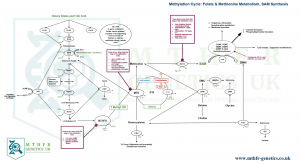Category: METHYLATION
Choline Pathway
Homocysteine Metabolism
Folate Cycle
 Methylation Pathway – Folate Pathway
Methylation Pathway – Folate Pathway
Sources of folates
Humans cannot synthesize folate and must derive it from diet or as a supplement, although the folate biosynthesis pathway in bacteria is well-defined (Ref.) and several bacteria in the gastrointestinal tract can synthesize B-vitamins, including folate, in quantities that resemble dietary intake (Ref.)
Various lactic acid bacteria naturally occurring in the human or animal gastrointestinal tract or used as starters in fermented foods are recognized for their folate-producing capacities (Ref.)
Two Species: Lactococcus lactis and Streptococcus thermophilus are well-known folate producers. (Ref.)
Strains of Bifidobacterium adolescentis, Bifidobacterium pseudocatenulatum and Bifidobacterium catenulatum were commonly recognised as strong folate producers too (Ref. )
The complex ecosystem in the colon and the fact that other bacteria also use folates, makes it very hard to establish what proportion of absorbed folates come from bacterial folate biosynthesis.
It is known however that bacterially biosynthesized folate available in the colonic lumen can participate in host metabolism after absorption.
Absorption of folates
The primary site of absorption of folate derived from dietary sources is the small intestine but absorption of biosynthesized folate (bateria manufactured) can occur in the colon (Ref.) but only to some extent, as demonstrated by fecal excretion of folate. (Ref. )
Absorption of folate may depend on various factors including variations in genes responsible for folate uptake and metabolism and the bioavailability of the specific forms of folate (Ref.) (Ref.)
Roles of the Folate Cycle
1. DNA production and repair
The folate cycle and the folate-mediated one-carbon pathways are part of the folate metabolic pathways. The metabolic cycle deals with the various facets involving transport, modifications and inter-conversions of different types of folates.
Folate is involved in a series of biochemical reactions commonly referred to as one-carbon metabolism.
The main output of one-carbon metabolism includes purine (adenine and guanine) and thymidylate biosynthesis, which are essential for DNA and RNA synthesis and repair (Ref.)
Human biochemistry has a bypass, compensation pathway designed to build and repair DNA in case of folate deficiency, however, the absence of folate in this process would make the DNA very unstable (Ref.)
One particular form of folate sits at the center of these reactions: Tetrahydrofolate (THF) is a soluble form of vitamin B9 that plays essential role in a number of metabolic pathways.
2. METHYLATION REACTIONS
Besides production of purines and thymidylate, folate-mediated one-carbon metabolism is involved in methylation reactions
The 5-methyl THF-mediated (commonly known as methylfolate) conversion of homocysteine to methionine and subsequently S-adenosylmethionine (SAMe), determines the availability of methyl groups that can be transferred to proteins, RNA and DNA. Enzymatic transfer of the methyl group to cytosine residues (CpG sites) in the DNA is facilitated by DNA methyltransferases (DNTMs) and is referred to as DNA methylation. This has been briefly described in this article.
Steps in Folate cycle biochemical reactions – tbc.
Cobalamin Cycle
Betaine Metabolism
METHYLATION OVERVIEW
| All of the sections listed in your report before the Methylation section, will have an impact on the functioning of your Methylation Pathway.
If you’ve already optimised your Gastro-Intestinal health, lowered your inflammation, addressed hidden infections and immune system function, optimised all aspects of your detoxification and mitochondrial function, then you have already addressed your Methylation Pathway in a very significant way. Now you can start being more specific with the genes and cycles you need to support, going forward. You may need to start addressing methylation, to some extent, while addressing your GI health, if your Homocysteine is high at that stage. Please note that many substances commonly used to address the methylation pathway, may have an impact on the levels of your neurotransmitters. Your specific genotypes, listed under the NEUROTRANSMITTERS section, may influence how you react to these substances, as far as mood and cognitive processing are concerned. |

